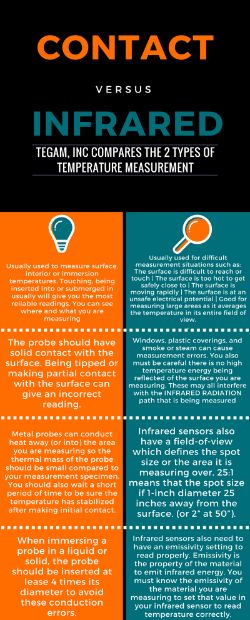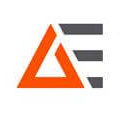Infrared: Non-Contact Temperature Measurement
已发布 一月 29, 2019 由 Advanced Energy Editor
What is Infrared?
How is Infrared Used for Temperature Measurement?
Infrared Thermometers use infrared energy is the portion of the electromagnetic spectrum between the red end of visible light and microwaves. Every form of matter with a temperature above absolute zero (0 K) emits infrared radiation relative to its temperature.
Infrared energy is a lower energy radiation than light. Think of a stove burner – as it heats up you can feel the “warmth” which is infrared radiation being transmitted by the burner. When it reaches a “higher” temperature, it also begins to give off light. Early thermometers in the metal industry used the color of the metal to determine its temperature, hence the terms “red hot”, “yellow hot” and “white hot”.
It is this “infrared light” that is used today by solid state sensors to measure the temperature of an object. Infrared radiation also has many commercial applications such as: communications over fiber optic cables, missile tracking, heating and cooling; even your TV remote uses infrared to communicate with your TV set.
Infrared energy covers the wavelengths of 1mm and 750 nm. It was typically divided into near-infrared, 120 – 750 nm, mid-Infrared 10 to 2.5µm and far-infrared 1mm to 10 µm. Recently it has been defined into 5 categories centered around how the various wavelengths are used.
| Near Infrared: | 0.7 to 1.4 µm | Fiber optic communications |
| Short Wave Infrared: | 1.4 to 3 µm | Combustion temperatures |
| Mid-range Infrared: | 3 to 8 µm | Heat tracking |
| Long Wavelength Infrared: | 8 to 15 µm | Temperature Measurement, heating/cooling, thermal imaging, night vision |
| Far Infrared: | 15 to 1000 µm | Infrared Spectroscopy and physics, heating |
Infrared Thermometers a.k.a. Non-Contact Thermometers
Non-contact thermometers, also known as infrared (IR) thermometers, measure temperature from a distance. To make a non-contact temperature measurement you need to measure the characteristic radiation of the object and the material property. This relative ability of a material to emit infrared energy is called emissivity. By knowing the amount of infrared energy emitted by the object and its emissivity, the object’s temperature can usually be correctly determined. Although all material gives off infra radiation each material does this at different energy levels depending upon factors such as surface finish.
The most important factors that can affect infrared temperature measurements are:
- The absorption of different infrared wavelengths by the atmosphere and/or “windows” that the infrared energy must pass through to reach the sensor
- The wavelength sensitivity of the IR Sensor
- Target emissivity
- Size of the target
- Field of view (FOV) of the Sensor
- Distance to target
- Ambient Temperature
- Stray infrared radiation
Two most common atmospheric issues you need to be aware of are water vapor and combustion byproducts.
- Water Vapor
There is a “sweet spot” in earth’s atmosphere roughly between 8 and 14µm wavelengths where water vapor does not absorb infrared radiation so most general-purpose infrared thermometers are filtered to this wavelength band.
- Combustion Byproducts
There is also a window where combustion byproducts (Carbon Dioxide [CO2 ]and Carbon Monoxide [CO]) do not absorb infrared radiation, this window is roughly between 1 and 3µm. Most high temperature infrared thermometers are filtered to measure the infrared energy in this range. The mineral sapphire which is often used as a window into high temperature ovens is also infrared transparent in this range.
Thermometer Types
The most common type of infrared thermometers are spot infrared thermometers. These have a fixed field of view and measure all the energy in that view. To properly use them, you must set the emissivity and make sure that you fill the entire field of view with the material you are measuring.
To set the emissivity, typically a contact surface measurement is made using a thermocouple thermometers and then the emissivity on the infrared thermometer is adjusted so they both read the same.
Two-color infrared thermometers measure the infrared radiation at two different wavelengths and take the ratio of the two to calculate temperature. Two-color infrared thermometers are typically used in higher temperature applications where smoke or other gasses are present.
Using new sensor arrays and optics, Infrared Night Vision devices have become available. They use the difference in infrared emitted by a warm living creature vs. the cold ambient background to “light up” the warm creature.
Thermal imaging brings focused infrared optics and temperature measurement together to create a thermal image or picture of what is in its field of view. They use a fixed emissivity, so the temperature is not exact, but they are used to show hot spots and thermal uniformity. Thermal Imaging is also used to “proof” insulation.
Infrared Temperature Uses
Infrared thermometers are used to make non-contact measurements. They are used with food products to ensure that they stay within safe ranges with no risk of contamination. Infrared is also the preferred way to measure moving parts or moving machines where contact measurements would require stopping the process and parts. Monitoring of high temperature ovens require opening a door and protective clothing in order to get a contact measurement therefore infrared is frequently the best option. Recently infrared measurement has also entered the health field in the form of forehead and ear thermometers to measure body temperatures.
For all applications, remember that an infrared non-contact measurement is only a surface measurement, not an internal temperature, so the core temperature of a food product cannot be measured using infrared. Consequently, environmental conditions such as moving air, stray radiation or changes in the surface can all affect infrared readings.
TEGAM designs and manufactures a large line of contact digital thermometers. Applications in which precise accuracy is important tend to use contact thermometers. You can review our latest models of digital thermometers on this link.
For further questions, comments, or to engage with us, please contact us here to get started.

